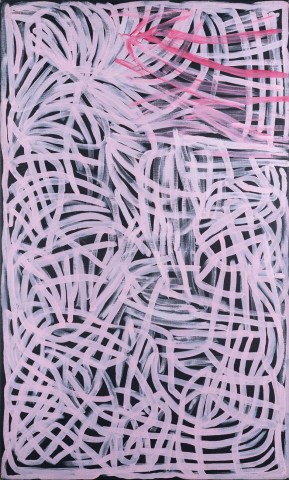AWELYE, 1995
EMILY KAME KNGWARREYE
synthetic polymer paint on linen
153.0 x 92.0 cm
bears inscription verso: artist’s name, Commissioned by Delmore Gallery, and Delmore Gallery cat. 095I057
Commissioned by Delmore Gallery, via Alice Springs
The Delmore Collection, Alice Springs
Private collection, Canberra
Contemporary Aboriginal Art from Delmore Gallery, Mary Place Gallery, Sydney, 14 December – 21 December 2007 (illus. in exhibition invitation)
This painting is accompanied by a certificate of authenticity from Delmore Gallery.
In his essay ‘Kngwarreye, Woman abstract Painter’,1 art historian Terry Smith recalls watching a video of Emily Kngwarreye in the process of painting Big Yam Dreaming (now in the collection of the National Gallery of Victoria, Melbourne) in July 1995. Revealing much about her painting technique, the video records Emily seated on the wide verandah at Delmore Downs Homestead working on the large black primed canvas, starting at one end and steadily working her way across the surface. In contrast to almost all other desert painters, Emily made no attempt to generate a repetitive pattern and rather, her method of mark making was to paint individual strokes – often starting from the edge of the canvas and moving in toward the centre as far as her reach extended – then sweep back and apply a third line that linked the first and second. This intimate process was related to the subject of her painting, the meandering nature of the rhizomatic roots of the Anooralya yam plant mirroring Emily’s lines which randomly spread across the canvas, intersecting, overlaying and crossing in a series of gestural strokes.
Emily Kame Kngwarreye began painting on canvas in late 1988 and quickly emerged as one of Australia's most sought-after painters. Renowned for her strength and certainty of hand, she developed a free-flowing style of painting based on the distinctive linear pattern of the underground roots of the yam plant (Vigna Lanceolata). This design, and myriad variations upon it, would either dissolve into fields of rich colour achieved through layers of painted dots, or as with this later painting, stand alone and become the graphic centrepiece of the work.
Awelye, was painted in September 1995 and is exemplary of Emily’s later style of painting. Reductive in the use of Emily’s lexicon with a palette limited to red, white and pink brush strokes drawn upon a black ground, the work exudes energy and the sweeping lines express a movement that leads the eye across all parts of the canvas. It is the gesture, the way that the paint has been applied that dominates this painting. The lyrical marks created by the expressive movement of the artist's outstretched arm reveal the physical relationship between the artist and the canvas, lending the painting a human scale while at the same time describing a broad stretch of her country. 'This is a striking instance of body and country becoming one, … a woman drawing her country with her body's reach’.2
1. Smith, T., 'Kngwarreye woman abstract painter', in Isaacs, J. et al., Emily Kngwarreye Paintings, Craftsman House, Sydney, 1998, p. 36
2. ibid., p. 32
CRISPIN GUTTERIDGE
